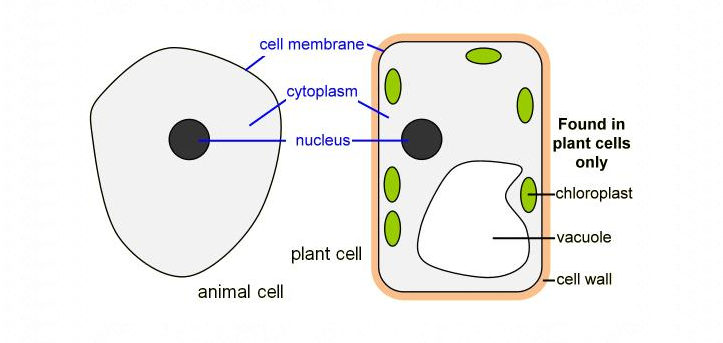In the last post, we discussed how life originated from what scientists nowadays know as the chemical soup. The chemical soup did not give rise to complex lives just as we have them now but life evolved from very simple forms, as simple as a single cell, gradually to the complex ones, and to the more complex ones as we have them today. The heterotrophic cells like bacterial cells were the first to evolve from the chemical soup and as their environment kept on changing, they kept evolving into more complex forms, such as the autotrophic cells, in order to cope with the changes. In today's post, we will be talking about the cell itself.

How the cell was discovered
The story of how the cell was discovered will not be interesting without the invention of the primitive compound microscope by a scientist known as Zacharias Jansen in the late 16th century. The microscope consisted of a system of two magnifying lenses placed at the opposing ends of a tube. Looking through the tube, Jansen discovered that an object at the opposite end of the tube appeared to be multiple times bigger depending on the strength of the lenses. Although the final images were blurry, the invention was significantly improved up by the late 16th century and this was the instrument that engineered the discovery of the cell.
Robert Hooke was the first scientist to observe, describe, and coin the word 'cell' in his book popularly known as micrographia - a book that consists of previously unseen and unknown organisms that were only discovered through the use of the microscope. Although what Hooke observed was called cells, in actual fact, what he observed were just the cell walls of dead plant cells - the cork cells.
The first live cells were observed by another scientists about a decade after in 1674. The Dutch man, Anton van Leeuweenhoek refined the microscope further and was able to observe live bacteria, spyrogyra, and other cells. The discovery of cell paved way to a significant development in biology as a subject.
Development of the cell theory
With the microscope now more advanced and the existence of cell established, scientist were able to focus more on the contents of the cell. Amost 2 centuries after the discovery of cell, two scientists - a Botanist and a Zoologist - in the name of Matthias Schleiden and Theodor Schwann were able to extensively study living tissues and formulate the unified cell theory from their various studies. This theory has 3 components, namely;
- The cell represents the basic unit of all living organisms just as the atom is the basic unit of all substances.
- All living organisms are made up of cells; the simplest ones must have, at least, a cell while the complex ones can have as many cells as possible.
- Cells arose from preexisting cells through the process of cell division.
Until it was modified to be what it is currently, the third part of the cell theory initially generated a bit of rancour among scientists because it was built on the theory of spontaneous generation propounded by Aristotle. According to this theory, life arose spontaneously. Hence, Matthias Schleiden and Theodor Schwann initially opined that cells arose by spontaneous generation, untill the theory of spontaneous generation itself was disproved. It was later that another scientist, Rudolf Virchow, conducted a series of research and opined that cells can only arise from preexisting cells.
Types of cells
Detailed study of different cells revealed that there are two types;
- Prokaryotic cells
- Eukaryotic cells
The prokaryotic cells were the first to evolve from the chemical soup according ti the chemosynthetic theory of origin of life. Hence, they are far simpler than the eukaryotic cells which were opined to have evolved millions of years later. Prokaryotic cells evolved without nucleus and other membrane-bound organelles that are characteristic of the eukaryotic cells. The absence of these organelles makes important life processes to be different between the two cells.
For example, oxidative phosphorylation takes place within the matrix of the mitochondrion in eukaryotic cells but takes place across the cell membrane of the prokaryotic cell. Also, the process of transcription takes place within the nucleus of the eurkaryotic cells while the translation of the mRNA takes place in the cytoplasm, unlike in prokaryotic cells where both transcription and translation take place simultaneously within the cytoplasm.

Many prokaryotic cells also have attachment or locomotive structures unlike the eukaryotic cells. Eukaryotic cells could be plant or animal cells and both cells have some variations in their structures. Plant cells have rigid cell walls made of complex polysaccharide (just like the prokaryotic cells) while animal cells lack any form of cell wall. The presence of a big vacuole and chloroplast in the structure of the plant cell also distinguish it from the animal cell.
References
- https://www.smithsonianmag.com/science-nature/what-we-owe-to-the-invention-microscope-180962725/
- https://bitesizebio.com/166/history-of-cell-biology/
- https://www.britannica.com/video/213697/Overview-scientist-Robert-Hooke-cell-theory
- https://bio.libretexts.org/Bookshelves/Introductory_and_General_Biology
Thanks for your contribution to the STEMsocial community. Feel free to join us on discord to get to know the rest of us!
Please consider supporting our funding proposal, approving our witness (@stem.witness) or delegating to the @stemsocial account (for some ROI).
Please consider using the STEMsocial app app and including @stemsocial as a beneficiary to get a stronger support.
Congratulations @ummar! You have completed the following achievement on the Hive blockchain and have been rewarded with new badge(s) :
You can view your badges on your board and compare yourself to others in the Ranking
If you no longer want to receive notifications, reply to this comment with the word
STOP